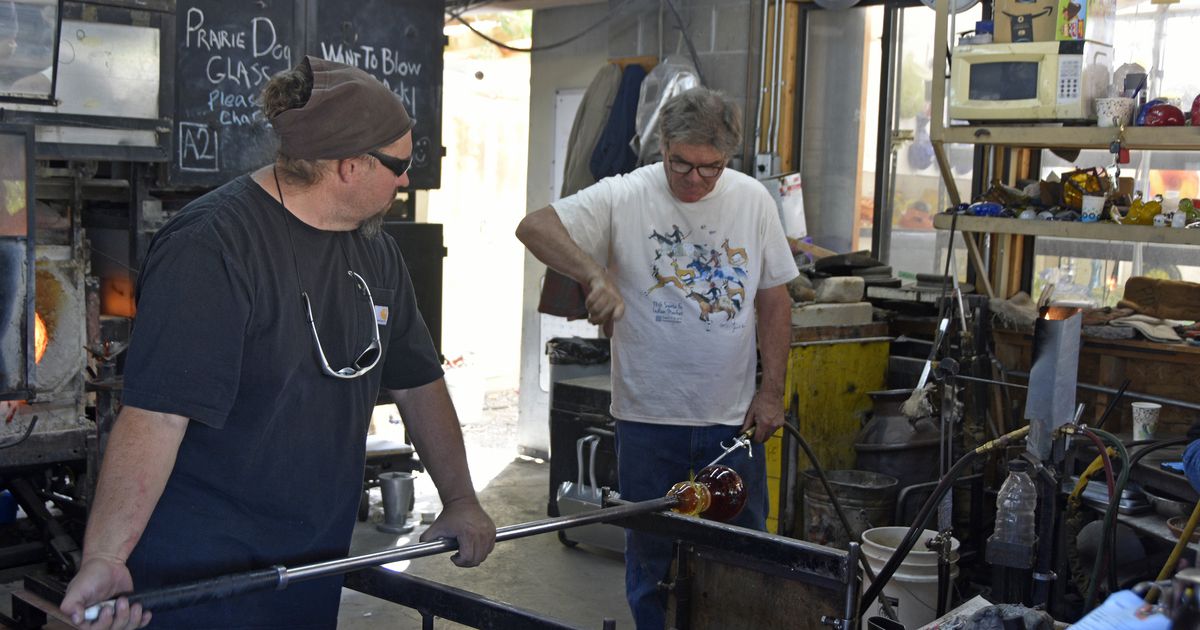It’s obvious these artists have been inspired by the baskets, textiles and pottery so integral to their personal history and have found innovative ways to interpret these ancient traditions in glass.
You’ll learn about the images on the glass that reflect myths and stories, animals of the land, air and sea. Among the artists and tribes included in the exhibition are: Dan Friday (Lummi), “Haila” Ho Wan Ut Old Peter (Skokomish/Chehalis), Preston Singletary (Tlingit), Tony Jojola (Isleta Pueblo), Carol Lujan (Diné), Priscilla Cowie (Māori) and Djambawa Marawili (Aboriginal Australian).
The traveling exhibit was curated by Letitia Chambers, who also wrote the accompanying book that’s sold in the museum gift shop. Of Cherokee descent, she’s been involved with the boards of organizations serving Native Americans. Chambers will be at the CMA on Sunday, March 10 to provide an in-depth look at the show.
What makes glass art so special? “It’s the combination of it being fragile but being a very strong material and the luminosity of glass is captivating,’ Chambers says. “Just the fact that these wonderful creations can be made in glass piques people’s curiosity. It’s not easy to create glass art, particularly blown glass.”
She says the artistry in glass is sometimes hard to believe. The “rugs’’ on display are a perfect example. Artist Carol Lujan’s grandmother was a Navaho weaver. Carol uses her grandmother’s patterns but instead of making them out of wool, she adapts them for glass. Amazing!
The Chihuly connection
In the 1970s, glass artist Dale Chihuly was sent to Sante Fe to build a hot shop and establish a program at the Institute of American Indian Arts. It was all part of a collaboration between the IAIA and the Rhode Island School of Design with the goal of creating accredited college legal courses of study, including a glass-blowing program.
The experience obviously changed Chihuly as you’ll see in his work in this exhibit.
Said Chihuly: “I had seen some beautiful Northwest Coast Indian
baskets… and was struck by the grace of their slumped,
sagging forms. I wanted to capture this grace in glass.”
The processes
Blown glass, says Chambers, is heated until it’s liquid, then picked up on the end of a blowpipe. “Then you blow into the pipe and the glass object begins to form. You then work that glass object, sometimes by hand with gloves on, sometimes with tools. Often there will be a team of people working on it, because it’s quite difficult.”
Another type is cast glass. “You make a mold and pour liquid glass into the mold, then put it into the kiln at high temperature,” Chambers explains.
In the exhibit, you’ll see many different ways glass can then be worked.
“Once glass has been blown or cast, it can be worked with tools, sandblasted, and sometimes –if it’s not fully hard– it can literally even be carved.”
Lujan’s “blankets’’ began with molds made of clay. The artist created the rug patterning by melting different colors of glass rods. When you see the large black vessel created by Tammy Garcia, you’d swear it was made out of pottery. “But it almost glows and as you look at it closely you see it’s glass,” notes Chambers. “Preston Sigletary blew the vessel and Tammy carved the design into the glass.”
Several of the artists have recreated dance or sacred ceremony regalia in glass– a headdress, a mask. “Their grandparents would not have used glass, they would have carved wood totems. But now we see examples of totems in glass.
“Native Americans today are living dynamic cultures, they continue to carry out traditional cultural activities but are also part of mainstream society. In the case of glass art, these artists have adopted a medium that is not traditional for them, but have used their traditional motifs and designs for what is for them a new medium.”
How to go
What: “Clearly Indigenous: Native Visions Reimagined in Glass”
Where: Cincinnati Museum of Art, 953 Eden Park Drive, Cincinnati
When: 11 a.m. to 5 p.m. Tuesday, Wednesday and Friday through Sunday; 11 – 8 p.m. Thursday. Closed Monday
Admission: $12, with discounted rates for students, children and seniors and can be purchased onsite and online. Admission is free for members. The exhibition will be free for nonmembers every Thursday evening from 5–8 p.m.
Parking: Free
More: cincinnatiartmuseum.org
- Don’t miss the Conversations Gallery on the first floor near the main entrance. What you’ll see here is a small exhibit created in collaboration with Cincinnati’s “Urban Native Collective” to increase understanding and generate dialogue about the contemporary experiences of Indigenous Peoples. There are some additional examples of glass art and some multimedia components, all aimed at emphasizing the interconnected nature of the environmental and social justice activism being undertaken by Indigenous communities locally and globally.
- The museum has a series of upcoming events related to the glass exhibit. They range from a lecture by curator Letitia Chambers to family art programs.

